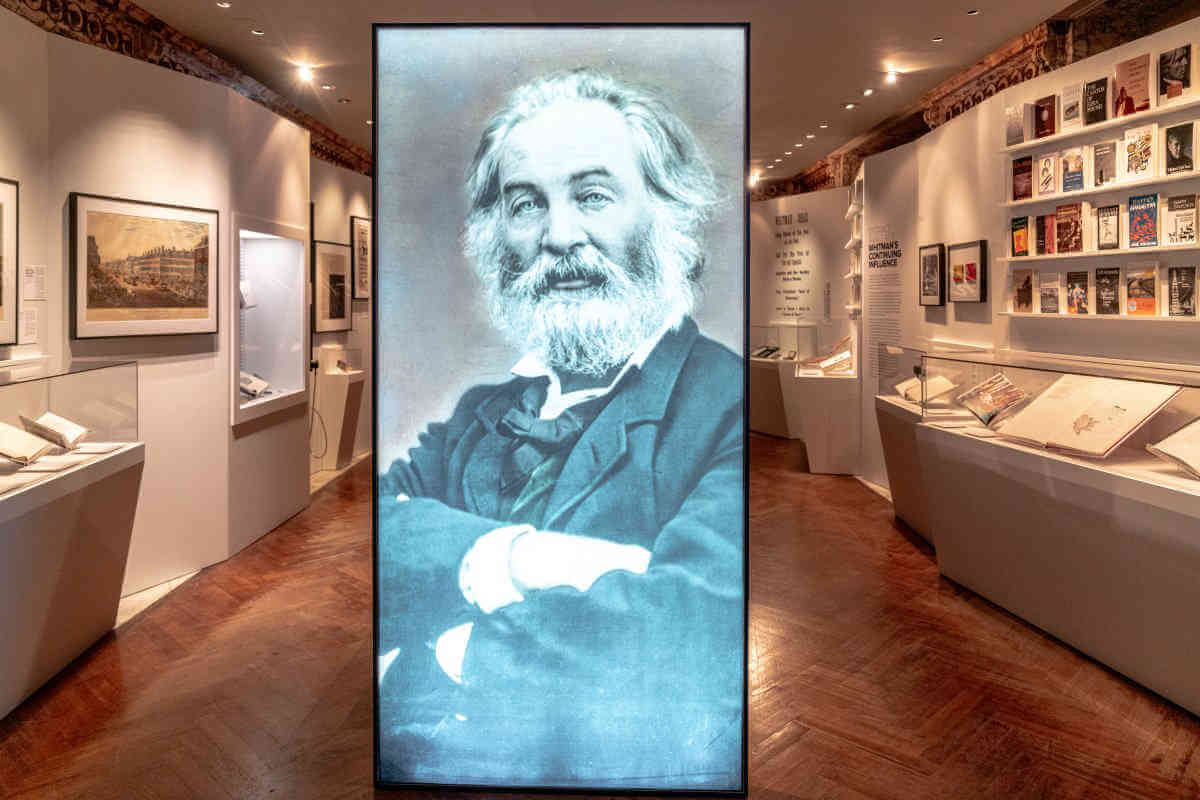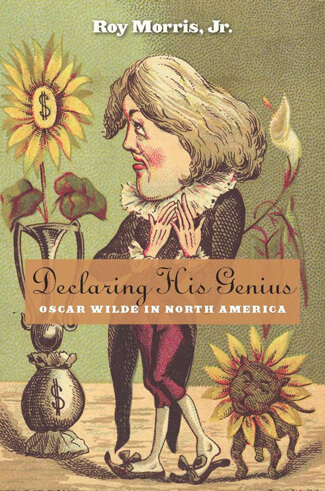The clear, open, and wondering eyes of a child stare out at you from Matthew Brady’s portrait of Our Good Gay Grandfather Poet in the New York Public Library’s show “Walt Whitman: America’s Poet,” running through July 27. Given this writer’s enduring, towering reputation and the exhibit’s portentous title, in observance of his bicentennial (May 31), no less, one might expect gallery after gallery of stuff relating to the man many consider our country’s national poet for all time.
What a surprise, then, to discover that the whole shebang is housed in a quite intimate first floor gallery not far at all from that famous pair of lions guarding the library façade, so beloved by tourist shutterbugs. It can become quite crowded in this room filled with students, Waltphiles, and other library denizens, so be prepared to be patient and as full of brotherly love as old Walt himself propagandized about his entire career.
A cursory overview of his lifetime emerges here, with a curatorial hand very much aware of making this 19th century scribe relevant to a generation more attuned to the rhythms of rap than epic poetry and whose only exposure to Whitman may be the “I Sing the Body Electric” dance number from the movie “Fame.” In his lifetime, Whitman personified the often penurious, picaresque existence of the freelance writer, being, at various times, a law office boy, printing press apprentice, journalist, teacher, volunteer nurse (in the Civil War), newspaper publisher, editor, typesetter, pressman, and government clerk in the Bureau of Indian Affairs.
Curated by Michael Inman, culled from the library’s various branch holdings of Whitmania, at times the exhibit seems almost as all over the place as Whitman’s job history, with everything from a letter to his mother to a beautiful, moss green (with gold lettering) edition of “Leaves of Grass.” That monumental work, unsurprisingly, gets the lion’s share of focus here. While it covered its creator in lasting glory, at the time its uncensored celebration of homosexual love also got him fired. Whitman was working in the office of Secretary of the Interior James Harlan in the summer of 1865, when Harlan came across a copy of it on the writer’s desk. Appalled by its content, he sacked the 46-year-old Whitman, which caused a rally among his friends and fans in support of him — and a new post in the office of Attorney General James Speed, whose brother Joshua had been Abe Lincoln’s Springfield roommate — in fact, bedmate — for several years. Both the book and Whitman’s firing letter are on display.

Inman has remarked on Whitman’s values of racial inclusivity and gender fluidity, so in step with beliefs that today, ironically, even absurdly, are often referred to as progressive: “While things [like the Civil War] were pulling the country apart, he was trying to point out the beauty of the individual, the sanctity of the individual, but also how individuality in a sense binds the country together.”
Other aspects of the show reveal the myriad outside influences that the ever-alert-to-his-surroundings Whitman found eclectically inspirational throughout his life: a staunch love of nature engendered by his childhood in rural Huntington, Long Island; the bustle of Manhattan, rife with new invention and creativity exemplified by the inception and exhibitions of daguerreotypes; master circus huckster P.T. Barnum, and, especially, music, everything from grand opera to the Hutchinson Family, a vocal toupe who sang about abolition, women’s rights, and temperance, which Whitman very much in supported in his time.
He wasn’t shy about self-promotion, either. The congratulatory letter which Ralph Waldo Emerson sent him after “Leaves of Grass” came out in 1855 was used again and again by Whitman to publicize subsequent editions of that 12-poem volume.
Dominating one side of the gallery is a huge and lovely sketch of two boys in bed, by David Hockney, shown next to a particularly frank homsexual passage. Here’s my cue to thank this writer personally for he way he helped me get out of a serious funk about myself and what, exactly, being gay was supposed to be about. I had spent one very young summer in the Fire Island Pines, the beginning of which found me poised and ready to experience what I, in my early 20s then, assumed would be the most fabulous season by the beach, amidst the bold, beautiful, successful crème de la gay crème.

Glamorous? Well, in a way, yes, as it was just before the onslaught of AIDS, very heady halcyon days, but, for shy, insecure 20-something me, it was just too much. Too much sex, drugs, disco, attitude, bitchiness, pretension — while severely lacking in any kind of real gay feelings of camaraderie, brotherhood, whatever, that I’d assumed would just be a given once any closet door was thrown open.
Basically, I saw a lot of people treating each other like toilet paper: to be used once and immediately discarded, and realized that “bitchy queen” wasn’t just a cliche but an all-too prevalent reality. I came back to the city truly shaken and thinking in my callowness that if that’s what being gay is, in its so-called highest echelons, I want no part of it. So then, what the fuck was I? And WHO?
Thank God for that one big room at the Metropolitan Museum holding four immense stone Buddhas to which I’d repair often, hoping some of their timeless calm would infiltrate me. And thank you, Walt Whitman, because “Leaves” truly helped me shake off that long depression.
The final stop of the exhibit features Whitman’s lasting influence, with books by the widest international range of authors of subsequent generations, all under his sway, on display, and even that episode of “The Simpsons,” with Homer mistaking Whitman’s gravestone for that of his own mother’s, and then suffering a meltdown with the discovery: “Damn you, Walt Whitman. I. Hate. You. Walt Whitman! Leaves of Grass — my ass!”





































